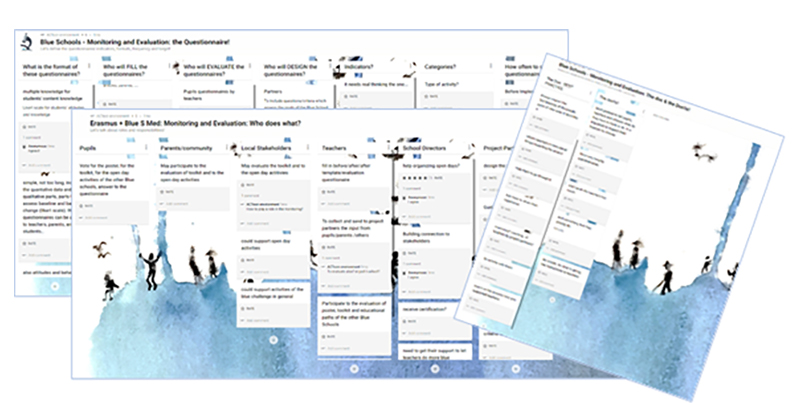Now that you have met the Blue Schools Med project, let’s start talking about our activities!
BlueS_Med is strongly connected to the Blue Schools Network, itself established by the EU4OCEAN coalition. Additionally, the Mediterranean Blue Schools seek to be active within the Mediterranean Sea basin Ocean Literacy actions. For this reason, a joint workshop was organized by ACTeon, with the support of members from the EU4OCEAN coalition, the Erasmus+ partners and other active marine educators!
Ever wondered how are school educational activities monitored and evaluated? With the first Blue School certification obtained recently, several questions arise on the M&E process of “Blue Schools Challenges”, particularly in the Mediterranean context.
It is in this framework that the workshop was planned, with the ultimate aim to design the best methodology for M&E of marine educational initiatives.
The workshop first began by listing concerns shared by partners related to the M&E processes, such as the additional amount of work this would entail on already pressured teachers, or targeted aspects of the project that should be evaluated, the indicators used throughout the process and even the need to resort to children psychology experts for an accurate analysis of the impacts!
To better solve these issues, it was important to start by defining the terminologies applied in this workshop: What is the difference between Monitoring and Evaluation?
| Montoring | Evalution | |
| When ? | Continuously: Throughout the project | Occasionally:
Before the start (Baseline); Mid-term ; At the end |
| What is measured? | Efficiency, activities & fieldwork, outputs… | Effectiveness, long term impact, achievement of purpose (Change in behaviour, increased awareness…), explore Unintended results… |
| Who is involved? | Pupils, community (parents etc.) (monitored) Who will monitor TBD! |
School Directors, Teachers, Local Stakeholders , Project Partners Who will evaluate? TBD! |
| Who uses the results? | School Directors, Teachers, Local Stakeholders, Project Partners | Project partners, funding entities, external entities/agencies |
| Sources of information | Questionnaires, surveys, videos, toolkits, teaching-learning sequences…
Indicators? Formats? Baselines? Benchmarking? |
|
| How to use the results? | Minor changes: To adapt activities For evaluation purposes |
Major changes: For strategic purposes, future work/activities, recommendations for improvement, best practice… |
A simple benchmarking exercise followed, mentioning examples such as ResponSEAble project, Aires Marines Educatives, and other personal experiences shared by project partners.

Three interactive sessions, using PADLET tool, gave room for a free and simultaneous expression of opinion by all partners, and covered the following issues:
- Questionnaires’ format and content: Who What Where When Why?
- Roles and responsibilities: Who does what?
- The Dos and the don’ts !
The outcomes of these discussions will be published in the Intellectual Output 1 deliverable, led by CNR (Italy), and will answer questions surrounding the M&E process for Blue Schools marine educational activities.
The next steps would be to DESIGN the questionnaires, which will be the result of an ongoing collaborative process between partners and schoolteachers, so stay tuned!


